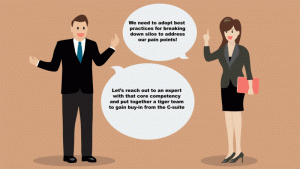Here’s how marketing leaders can address hybrid work challenges, from enhancing decision-making processes to tackling meeting hurdles.
Remote or hybrid working environments have been a fact of life for many marketing organizations since COVID-19 arrived in 2020. Not only has remote working not gone away, there’s evidence that the incidence has continued to increase, specifically for marketers through the first half of 2023.
I recently helped an organization work through its challenges with hybrid work. We didn’t resolve all the issues but started to make tangible progress on all the decisions bugging leaders when they could no longer see the staff physically working in front of them.
Organizations are settling on an uneasy position for remote work. On one hand, many employees do not want to come back to the office full time, while on the other hand, managers and leaders want people in the office more days, ideally all five.
Many leaders feel like they are in an old cowboy movie, stuck in a standoff with their team. The reality is that everyone wants the same goal (helping the organization succeed). Still, there are disagreements on how to get there.
In this article, I want to share several ideas to help marketing leaders make better decisions about how work gets done inside your organization. Before we jump into that, let me dispel myths about the effectiveness of remote work.
Does remote actually work?
Spoiler alert — no one knows. If you’re the kind of person who enjoys evidence-backed ideas, then you’re about to be disappointed. Studies are unclear whether employees are more effective at home or in the office.
These varied conclusions make sense. Your effectiveness will vary greatly, depending on your circumstances.
Do you have children at home who constantly come into the office during work hours? You’re unlikely to be effective.
Do you get frustrated when you’re constantly interrupted in the office despite wearing headphones? You’re likely to be more effective in the quietness of your own home.
There’s no value judgment on your preferences, but you should get crystal clear on how you enjoy working. Some people thrive on in-person contact while others prefer not to see anyone for days.
We can also find plenty of examples to support either side. Remote-first companies like Zapier and Automattic (maker of WordPress) have created successful companies without ever having an office. Both companies bring people together physically multiple times per year.
At the same time, companies like Apple and Uber have shown that in-person work is highly beneficial for some cultures and organizations.
The point here is that you can’t simply rely on academic data. You need to understand who is actually part of your organization and the best setup for them.
When I lead strategic sessions, we often have a section defining operational values. The list starts with vague words like respect and honesty but doesn’t capture what a team tries to say. No organization is going to say that their operation values include being disrespectful to others and lying.
The key is to turn vague words into concrete language. When we say respect, we mean that we are willing to disagree on opinions, but I will continue to respect your expert assessment. Honesty means that we will share different ways of improving our performance with each other, even when it feels awkward and rude.
Challenges in remote work need to be converted into tangible language. What are the actual issues you’re facing? Perhaps you feel that decisions are being made slower, you don’t know what everyone is working on, or you can’t get a hold of people during work hours. Make it tangible, and you can start to tackle it.
The biggest challenge is meetings
In my experience, the biggest challenge for hybrid teams is meetings. I recently talked to a newspaper editor complaining about remote work. His newspaper was struggling to re-sign advertisers after the pandemic, and he felt everything was moving slower because he couldn’t talk with employees to make critical decisions.
He’s completely right about the lag. If everyone is in the office, you can simply walk to their desk to talk to them. Reaching people by phone can introduce a lag of a few hours, slowing down decisions.
The solution is to break down decisions into before, during and after stages.
- Before making a decision, you will need research, analysis and other elements.
- During a decision, you will need discussion and debate.
- After, you will need accountabilities and next steps.
The before and after stages can typically happen “offline,” while the during stage benefits from a video call or an in-person meeting. Organizing your decisions into stages means you don’t have to talk to people constantly. You can assign clear tasks and schedule meetings to make the actual decision.
Teams that used to be in-person all the time are accustomed to calling meetings in all the stages.
“Let’s schedule a meeting to discuss what we need before we make the decisions.”
“Let’s schedule a meeting to discuss the decisions.”
“Let’s schedule a meeting to talk about next steps.”
That level of inefficiency does not work in hybrid environments. You need a better way of handling meetings.
Making in-person days count
I don’t believe most organizations will be 100% remote or 100% in-person. Instead, we will see reasonable compromises with people coming into the office two or three days a week.
That means leaders need to figure out how to make in-person days count. There’s no point in bringing people to do the same work they could do at home. Seeing people working on their laptops with headphones on may give you some comfort, but it is a waste of time.
When I was a kid, I loved going to summer camp. It was completely different from school (with no homework), even though it occurred in the same building. I would not have gone if I had been told to spend my summers doing the same thing as regular school. You should think of your in-person days as summer camp. Unique, fun and completely worth the commute.
Think about what kind of work can only happen in person. Brainstorming sessions, strategic discussions, feedback, professional development and so forth should be at the top of your list. Let people do research, analysis, writing and other things on their own time at home. Design in-person days that remind people why they chose to join your organization.
Conclusion
I recently helped an organization design a future where their team is hybrid 50% of the time. Their leaders were nervous but also excited about the possibilities. It means reworking how their customer support team operates, adding a few missing technology pieces and leveling up their communication skills.
That’s how you should think about remote work. Think boldly and then turn concerns into tangible next steps. Remote work is here to stay for most organizations, including marketing organizations. It’s time to figure out how to make it work.
The post How hybrid teams can make better decisions appeared first on MarTech.
MarTech(3)


